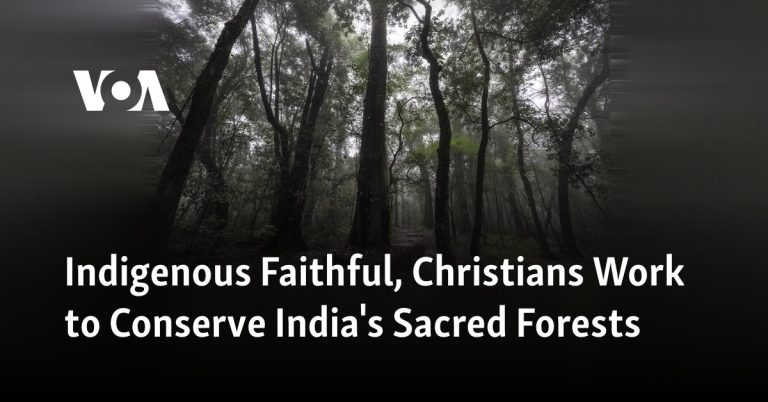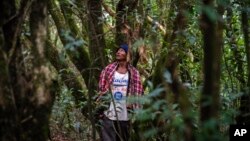Tambor Lyngdoh made his way through the fern-covered forest – naming plants, trees, flowers and even stones – as if visiting older family members.
The community leader and entrepreneur was a little boy when his uncle brought him here and told him these words: “This forest is your mother.”
This sacred space is located in the village of Mawphlang, nestled in the lush green Khasi Hills in the northeastern Indian state of Meghalaya, whose name means “abode of the clouds”. On a cloudy day, the forest, a 24-kilometer drive from the state capital of Shillong, was quiet except for the chirping of crickets and raindrops rustling the bright green foliage.
The ground, carpeted with fallen leaves and green saplings, was dotted with moss-covered sacred stones, which for centuries served as sacrificial altars and receivers of chants, chants and prayers.
Mawphlang is one of over 125 sacred forests in Meghalaya, and arguably the most famous. These forests are ancient, pristine woodlands that have been protected by indigenous communities for many centuries; comparable extents have been documented in other parts of India and around the world, from Nigeria and Ethiopia to Turkey, Syria and Japan.
In Meghalaya, these forests represent an ancient tradition of environmental conservation, rooted in indigenous religious beliefs and culture. For hundreds of years, people have come to sacred groves to offer prayers and animal sacrifices to the deities they believe reside there. Any form of desecration is taboo; in most forests, it is even forbidden to pick a flower or a leaf.
“Here, communication between man and God takes place,” says Lyngdoh, a descendant of the priestly clan that sanctified the Mawphlang Forest. “Our ancestors set aside these groves and forests to symbolize the harmony between man and nature.”
Many of these forests provide the main sources of water for the surrounding villages. They are also treasures of biodiversity. Lyngdoh has at least four species of trees and three types of extinct orchids outside the sacred grove of Mawphlang.
Today, climate change, pollution and deforestation threaten these spaces. They were also affected by the conversion of the indigenous population to Christianity, which began in the 19th century under British rule. Christian converts have lost their spiritual connection to the forests and their traditions, said HH Morhmen, an environmentalist and retired Unitarian minister. Meghalaya is 75% Christian in a country that is almost 80% Hindu.
“They saw their new religion as light and these rituals as darkness, as pagan, even evil,” he said.
In recent years, environmentalists working with indigenous and Christian communities as well as government agencies have helped spread the message about why forests are invaluable to the region’s ecosystem and biodiversity. , must be maintained. Morhmen said the work is paying off in rural communities.
“We now see that even in places where people have converted to Christianity, they take care of the forests,” Mohrmen said.
An example of this is the village of Mustem in the Jaintia Hills. Heimonmi Shylla, head of the hamlet which has about 500 households and a deacon, says almost all residents are Presbyterian, Catholic or members of the Church of God.
“I don’t consider the forest sacred,” he said. “But I have great respect for that.”
It serves as a source of drinking water for the village and constitutes a sanctuary for fish.
“When it’s very hot, the forest keeps us cool,” he said. “When you breathe that fresh air, your mind becomes fresh.”
Shylla worries about climate change and insufficient rainfall, but said there are plans to promote tourism and “make the forest greener” by planting more trees.
Petros Pyrtuh takes his 6-year-old son, Bari Kupar, to a sacred forest near his village, also in the Jaintia Hills. He is Christian, but says the forest is an important part of his life; he hopes his son will learn to respect him.
“In our generation we don’t believe this is the abode of the gods,” he said. “But we maintain the tradition of protecting the forest because our ancestors told us not to defile it.”
BK Tiwari, a retired professor of environmental sciences from North Eastern Hill University in Shillong, is heartened to note that conversion to Christianity has not completely disconnected the people from the land.
“In indigenous religion, everything is sacred: animals, plants, trees, rivers,” said Tiwari, who has studied the biological and cultural diversity of Meghalaya’s sacred forests. “Now they may not feel any connection to the divine or spiritual, but as a culture they understand their role as guardians.”
Donbok Buam, a native of Jaintia Hills who still practices the indigenous faith, explained that in the sacred forest of his village, rituals are performed at the confluence of three rivers in honor of the goddess Lechki, a forest dweller and guardian of the village.
“If people have a problem or illness or if women are having trouble conceiving children, they go there and perform sacrifices,” Buam said.
One of the rituals involves carrying water from the river before daybreak and offering it to the goddess at a specific location in the forest. The water is poured into calabashes and placed next to five betel nuts and five betel leaves – four for the rivers and one for the sacred forest. A white goat is sacrificed in honor of the forest deity, he said.
“We believe the goddess walks in the forest even today,” Buam said.
The Nongrum clan is one of three clans that care for the sacred Swer Forest near Cherrapunji, an area about 56 kilometers southwest of Shillong that is among the wettest in the world. They follow the pantheistic Seng Khasi religion, according to which God exists in everyone and everything. The forest is a temple where their deities reside, and rituals are performed to ward off war, famine and disease, said Knik Nongrum, chairman of the local committee that looks after the forest.
“When there is a healthy forest, there is prosperity in the village,” he said, vowing that this forest will continue to thrive because his clan is determined to continue the traditions established by their ancestors.
Like most sacred forests, this one is not easily accessible from the road. It is located at the top of a steep hill whose terrain can become dangerous if hit by a downpour – as it often does. It is impossible to enter the forest without feeling the brush of twisted branches, breathing in the scent of flowers and herbs, and being watered by the droplets of water shaken by the leaves.
The part of the forest that people consider sacred is a patch covered in leaves and surrounded by thick, tall trees.
Most rituals are performed only during times of turbulence; the most recent tribulation was the global coronavirus pandemic. A particular ritual – the sacrifice of a bull – is performed by the head priest once in his lifetime, a practice which gives him the power to perform other rites for his community.
Jiersingh Nongrum, 52, pointed to the sacrificial altar just outside the forest, which has a crater in the middle where the animal’s blood pools. He was 6 years old when he witnessed this unique sacrifice.
“It was such an intense experience,” he said. “When I think about it today, I feel like I have a vision that I can’t even properly describe in words.”
Some sacred forests also serve as ancestral burial sites, said Hamphrey Lyngdoh Ryntathiang, the chief caretaker of one such forest in the Khasi Hills. He practices the Khasi faith and his wife is Christian.
Each forest has its own set of rules and taboos. In this forest, people can take fruit from the trees, but they are prohibited from burning anything, he explained. In others, fruits can be picked from the tree, but must be eaten in the forest. Deities are believed to punish people when there are disturbances.
Lyngdoh of Mawphlang is Christian, but he participates in forest rituals, invoking the deities believed to appear like a leopard and a serpent. He also sees the effects of climate change on the region’s forests and notes invasive birds, fungus-infested trees and endangered species.
In rural Meghalaya, the poorest people depend most on the land, Lyngdoh said, emphasizing that forests can be both life-giving and economic engines, providing water and promoting tourism.
“But most importantly, a sacred grove is set aside so that we can continue to have what we have had since the creation of this world.”




